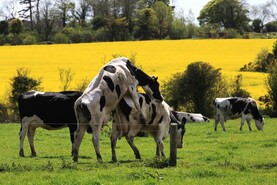The concept of breeding healthier sheep was discussed by Áine O’Brien of Teagasc at the recent Sheep Ireland/ICBF genetics conference to celebrate 10 and 20 years in existence.
Three traits were highlighted – lameness, dagginess and mastitis. All three fit the criteria of being including in a breeding goal which, according to Áine, include being socially or economically important, exhibit genetic variation and are measurable on a large scale or correlated with a trait that is.
The phenotypes used to record dagginess is a score system ranging from one to five while lameness is recorded as no evidence or lameness or any sign of lameness.
A similar approach is used for mastitis, with no evidence of mastitis or evidence of existing or historic mastitis.
Variation
Looking at dagginess in isolation the current prevalence recorded by Áine was 30.2% of adults and 22.2% of lambs but there is significant variation between sires from as low as 0% prevalence to 75% prevalence. There was a similar trend for lameness with a spread of 0% to 45%.
The data was extracted from 39,315 records across the five main breeds Belclare, Charollais, Suffolk, Texel and Vendeen.
Heritability estimates were recorded at 14% to 15% for dagginess while lameness was estimated at 6% to 12% and mastitis at 4%, although the low heritability could be influenced by a lower recording rate due to the possibility of ewes being culled or dying with the cause not recorded as mastitis.
Healthier sheep
Áine summed up by highlighting that we have the tools to breed healthier sheep and therefore we should now be using them.
As such, dagginess and lameness are now included in the terminal index (1.15% for dagginess and 0.11% for lamb lameness) and replacement index (0.17% for dagginess, 0.02% for lamb lameness and 0.04% for ewe lamness). This is a first in sheep breeding programmes and further research is taking place in other relevant health traits.
Read more
Breeding healthier sheep with lower greenhouse gas emissions
Looks can be deceiving when making breeding decisions
The concept of breeding healthier sheep was discussed by Áine O’Brien of Teagasc at the recent Sheep Ireland/ICBF genetics conference to celebrate 10 and 20 years in existence.
Three traits were highlighted – lameness, dagginess and mastitis. All three fit the criteria of being including in a breeding goal which, according to Áine, include being socially or economically important, exhibit genetic variation and are measurable on a large scale or correlated with a trait that is.
The phenotypes used to record dagginess is a score system ranging from one to five while lameness is recorded as no evidence or lameness or any sign of lameness.
A similar approach is used for mastitis, with no evidence of mastitis or evidence of existing or historic mastitis.
Variation
Looking at dagginess in isolation the current prevalence recorded by Áine was 30.2% of adults and 22.2% of lambs but there is significant variation between sires from as low as 0% prevalence to 75% prevalence. There was a similar trend for lameness with a spread of 0% to 45%.
The data was extracted from 39,315 records across the five main breeds Belclare, Charollais, Suffolk, Texel and Vendeen.
Heritability estimates were recorded at 14% to 15% for dagginess while lameness was estimated at 6% to 12% and mastitis at 4%, although the low heritability could be influenced by a lower recording rate due to the possibility of ewes being culled or dying with the cause not recorded as mastitis.
Healthier sheep
Áine summed up by highlighting that we have the tools to breed healthier sheep and therefore we should now be using them.
As such, dagginess and lameness are now included in the terminal index (1.15% for dagginess and 0.11% for lamb lameness) and replacement index (0.17% for dagginess, 0.02% for lamb lameness and 0.04% for ewe lamness). This is a first in sheep breeding programmes and further research is taking place in other relevant health traits.
Read more
Breeding healthier sheep with lower greenhouse gas emissions
Looks can be deceiving when making breeding decisions






 This is a subscriber-only article
This is a subscriber-only article









SHARING OPTIONS: